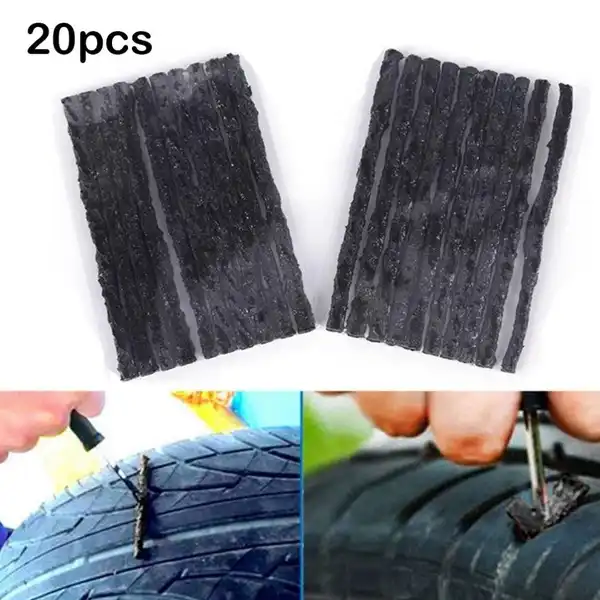USA HQ & WAREHOUSE BOULDER, CO | KLARNA FINANCE AVAILABLE | 60 DAY RIDE & RETURN
Road Bike Tubeless tires are a fantastic upgrade to any road bike. Benefits include increased grip, lower rolling resistance and increased puncture resistance. Our tubeless tire fitting service is a quick and easy introduction to the world of road bike tubeless tires however we often receive questions about tubeless tyre maintenance and puncture repair.
The aim of this blog is to answer some of the most common questions and give you a better understanding of the practicalities of running tubeless tires.
A huge advantage of road bike tubeless tires is the reduced risk of puncture. There are two reasons for this, firstly as there is no inner tube the risk of pinch punctures is totally eliminated. The second reason is the latex sealant used ensures that the tire remains airtight and is sealed to the wheel rim. The sealant contains tiny rubber particles that plug holes and repair punctures on the go. They are designed to seal holes up to approximately 2 mm wide so for most common punctures such as a small piece of glass, stone or a thorn the sealant will instantly block the hole sealing the puncture. Often you will be unaware that you have even had a puncture and it’s not until you finish your ride and spot a small damp patch on the tyre that you realise the sealant has sealed a hole.
Of course tubeless tires are not totally puncture resistant and the sealant will struggle to repair larger tire cuts. The high air pressure can force the sealant through rather than sealing larger holes.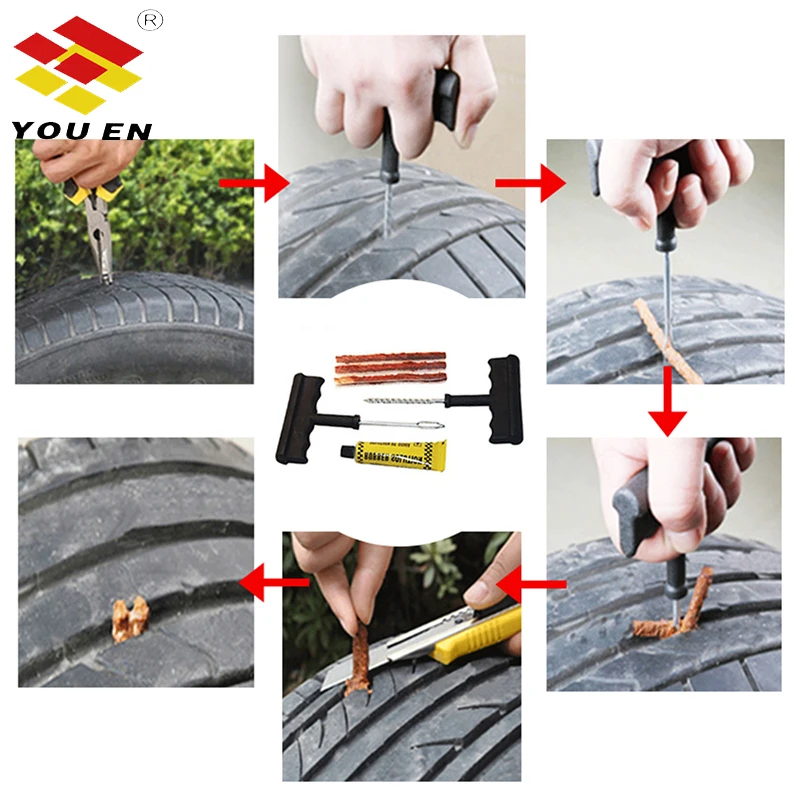 The pressure may drop slightly in the tire as some air is lost and thus also allow the sealant to seal the hole and it is still possible to ride home on tires with around 60 psi in them. However, there are a couple of quick and easy solutions to get you back up and running if you are unfortunate enough to suffer from a tire cut that won't seal.
The pressure may drop slightly in the tire as some air is lost and thus also allow the sealant to seal the hole and it is still possible to ride home on tires with around 60 psi in them. However, there are a couple of quick and easy solutions to get you back up and running if you are unfortunate enough to suffer from a tire cut that won't seal.
Tubeless Plug kits are a quick and easy method of fixing a tubeless puncture. Essentially the tubeless plug kit is a piece of rubberised cord that you force into the tire cut. The plug fills the hole in and allows the latex sealant to work sealing the puncture. The tubeless plug kit is a very quick and easy way to fix a punctured tubeless tire on the road side and you can continue to use the tire for many miles after the repair.
The most common method of fixing a tubeless puncture is to simply fit an inner tube.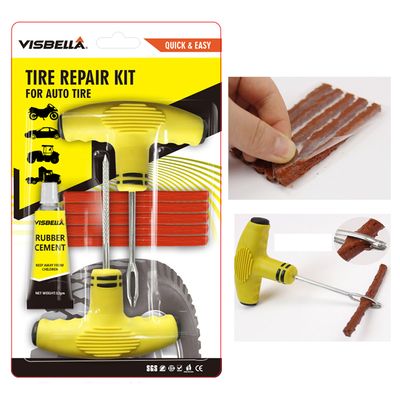 This repair is a quick and easy way to get you home. You will have to remove the tubeless valve by undoing the lock ring and then fit a new inner tube as you would with a standard clincher wheel. Remember to check that there is nothing sharp on the inside of the tire such as glass or sharp stones as the sealant may well have sealed numerous other punctures with the sharp object still in place. Just make sure you have a spare tube with you out on your rides and make sure the valve is long enough if you are using deep section rims.
This repair is a quick and easy way to get you home. You will have to remove the tubeless valve by undoing the lock ring and then fit a new inner tube as you would with a standard clincher wheel. Remember to check that there is nothing sharp on the inside of the tire such as glass or sharp stones as the sealant may well have sealed numerous other punctures with the sharp object still in place. Just make sure you have a spare tube with you out on your rides and make sure the valve is long enough if you are using deep section rims.
Once home (after fitting an inner tube &/or tire boot) it is possible to repair smaller cuts in a tubeless tire with tube patches. We will often secure the patch and reinforce the tyre by applying duct tape to the rear of the repair (inside tire) and even sometimes using superglue to seal the tread back together, however please check with your tire manufacturers advice on this before undertaking such a repair.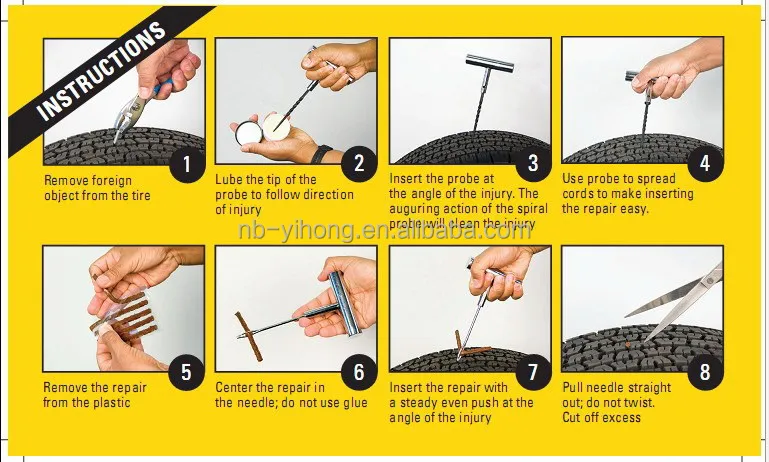
There are couple of reasons for unexplained pressure loss in tubeless tires. The first has already been addressed and that is simply that the latex sealant has dried up. The simple solution is to top up the tyre with sealant and this should then seal the air leaks.
Another issue can be damaged rim tape. If the tire has lost pressure or you have changed tyres the rim tape can become damaged or in some cases peel up. Renewing the rim tape ensures a good seal with the rim and will seal any unnoticed leaks.
The sealant used in a tubeless tyre setup is designed to quickly plug small holes, often without you even realising.
However, sometimes the size or the location of the puncture will require more than sealant to fix it.
Here’s how to repair a punctured tubeless tyre using tubeless plugs, patches or sewing.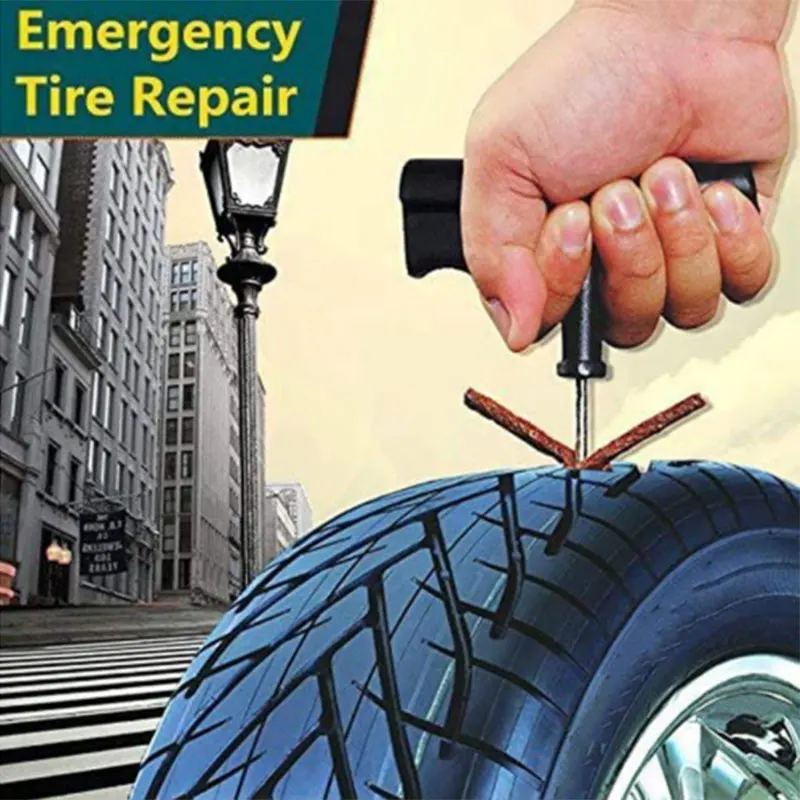
Tubeless punctures are often easy to find: look for tell-tale sealant or listen for the hissing of lost air pressure.Immediate Media
These days, a tubeless plug kit is a key part of any rider’s tool kit.Steve Behr
To repair a tubeless tyre puncture, you will require
For a more serious or stubborn puncture, you may need a tyre patch and/or a needle and thread.
If your sealant has dried out, you might need to refresh it.Russel Burton
You may also require:
Tubeless puncture plugs are a quick and effective solution. With these, there is no need to take off the tyre – just plug, re-inflate and go.
With these, there is no need to take off the tyre – just plug, re-inflate and go.
While there are a number of tubeless repair kits out there, most work in a similar way, using a rubber plug to fill the hole.
Once you’ve found the puncture, remove any offending items (a pick or a small pair of pliers are a useful addition to your tool bag for this very purpose).
Next, use your tubeless plug tool to make sure there’s a sufficiently large hole for the plug to enter – carefully insert the spike into the tyre to avoid damaging the rim tape, and twist to give a clean, round hole.
Thread a tubeless plug through the head of the tubeless plug tool. Most tools will come with a choice of different plug sizes to suit the size of the hole.
With the plug in the centre of the tool, insert it into the tyre, making sure you don’t push through fully.
Then twist carefully to slowly remove the tool, leaving the two ends of the plug on the outside of the tyre.
Inflate the tyre to your desired pressure, taking additional caution with high-pressure road tyres, and rotate the wheel so that the plug is at the ground for a few minutes before you get going again.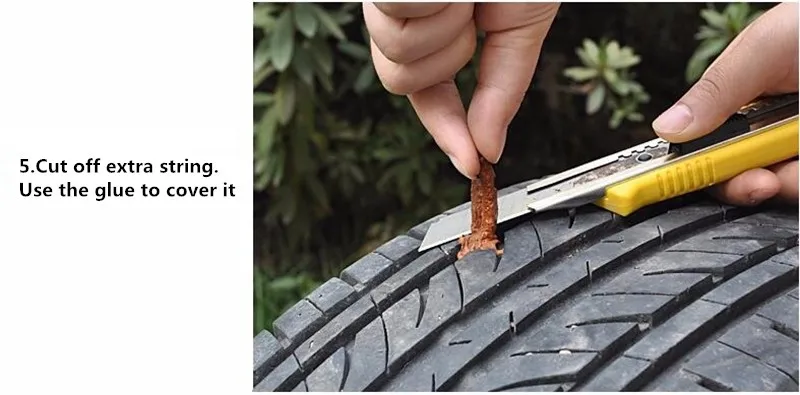 This will allow some sealant to flow into the repair and fully seal things.
This will allow some sealant to flow into the repair and fully seal things.
You may need to trim the tails of the plug that are left behind, but take care not to cut it too close to the tyre.
For more stubborn tubeless tyre punctures that can’t be fixed with a plug, it may be necessary to patch the tyre internally. The process for this is very similar to patching an inner tube.
First, you’ll need to roughen the surface that you want your patch to adhere to, using a little sandpaper, making sure there’s no debris left from the puncture. Cleanliness is key when it comes to gluing patches.
Add some vulcanising rubber solution to the area where you want to add the patch, waiting for it to become tacky as per the kit instructions.
Add the tubeless tyre patch and press down firmly. Try to avoid touching the surface that is to be glued because this can contaminate the adhesive.
Depending on the patch type, these may need minutes or hours to dry, before setting the tyre up tubeless as normal.
If successful, a patched tubeless tyre can last for many rides, often to the end of the tyre’s life.
A torn tyre can be a rider’s worst nightmare. These repair options should be viewed as a way to help you limp home before fitting a new tyre, rather than a long term solution.
A tyre boot can be placed on the interior of the tyre without any adhesive, held in place by the addition of an inner tube.
This flat boot keeps a flush internal surface to prevent the inner tube from bulging out of the slashed tyre. You can buy pre-made boots or make one out of a number of materials: toothpaste tubes, a section of inner tube or cash notes all work surprisingly well.
You’ll need a strong thread and needle to sew a tyre, such as this thick nylon or tooth floss.Immediate Media
If you don’t have a boot but you do happen to have tooth floss and a needle, you can actually sew up a torn tubeless tyre.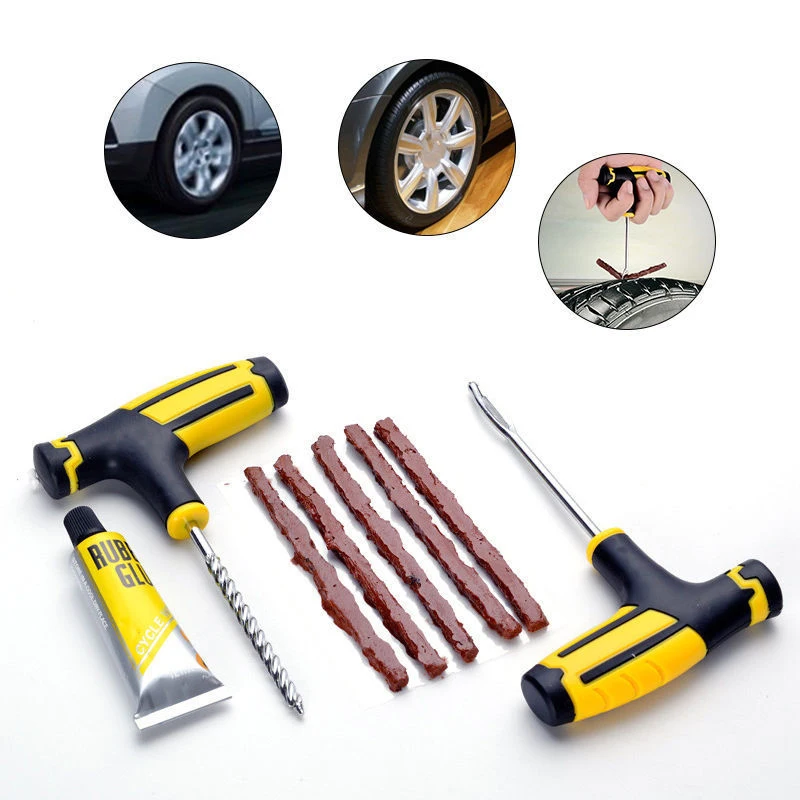
Using stitches perpendicular to the direction of the slash can help hold the casing of the tyre together before you insert an inner tube.
If you do use this method, it’s a good idea to add something between the sewn rubber and inner tube, such as a strip of strong tape.
If you are heading to the hills for an extended bikepacking or touring trip, packing a needle and thread is a good idea for this and any other fabric repairs.
No matter how hard you try, there’s always the chance a tubeless tyre might not be fixable on the road or trailside. Inserting an inner tube can be a mucky business with sealant already in the tyre, so it’s generally a last resort.
Before fitting an inner tube, thoroughly check the tyre for any punctures or offending items such as thorns. Just because you’ve found one, doesn’t mean there won’t be more embedded in the rubber waiting to puncture your inner tube too!
You can still get snakebite punctures with tubeless too, so make sure you’re running adequate pressures in your tyres, especially over harsh or rocky terrain to avoid a nasty double puncture from an impact on the rim. These are notoriously tricky to fix, with holes often too close to the tyre bead.
These are notoriously tricky to fix, with holes often too close to the tyre bead.
Besides punctured tyres, there are other things that need careful maintenance to keep your tubeless set up running smoothly, including the rim tape, tubeless valves and sealant.
It can be pretty hard to sort these on the go, so that’s when you might need to pop in a tube and leave the closer inspection until you’re home.
Katherine Moore is Bristol-based gravel and bikepacking expert who judges her rides by stoke level, rather than speed. When she’s not scouting out the best long-distance and local off-road routes in the UK, Katherine works as a freelance writer, bike tester, presenter and guide. Katherine is the former editor of advntr.cc and has also worked as a presenter on the Global Cycling Network. As well as being a regular contributor to BikeRadar.com and the BikeRadar Podcast, Katherine has also written for Cycling Weekly, Bikepacking. com and hosts the Unpaved Podcast. If you’re out on the trail you’ll likely see her from a mile off, thanks to her rather bright colour palette!
com and hosts the Unpaved Podcast. If you’re out on the trail you’ll likely see her from a mile off, thanks to her rather bright colour palette!
Car repair,
Each of the drivers may have such a situation when a tubeless tire deflated on the way, but the spare tire was not in the car, or for a long road this is already the second wheel. In this case, there are only two ways out - one way or another, wait for help from others (take the wheel to a tire fitting, call to bring a spare tire, call a tow truck, etc.), or you can repair a punctured tire yourself. nine0003
Before moving on to the topic itself, it is worthwhile to carefully study all aspects of the operation of tubeless tires, but their widespread use has clearly proved that they have a clear advantage over tube wheels.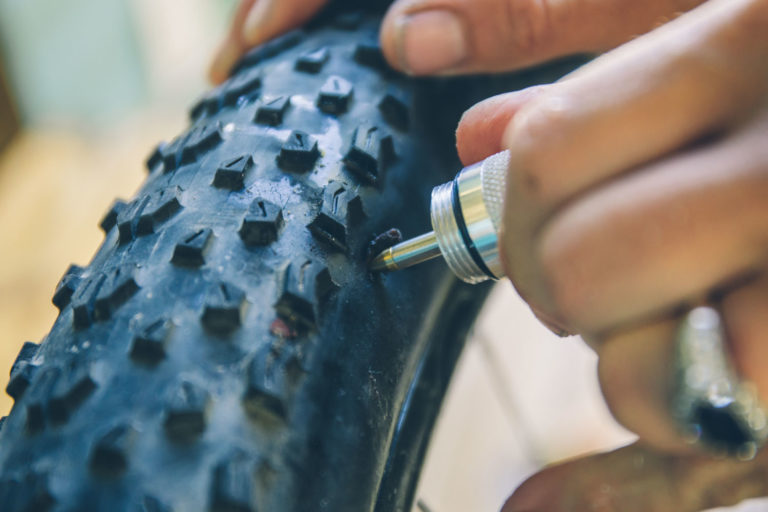
The main advantage for the driver is the ease of repair, because if a wheel with a chamber is punctured, it will have to be removed and disassembled in order to remove the chamber, and only then carry out the repair itself, and then you will have to do laborious work (if it is done without special equipment) in reverse order. Tubeless tires, in most cases, can be repaired without dismantling the wheel, and without even removing it from the car. nine0003
In addition, when punctured, a tubeless tire deflates for a long time, and sometimes drivers ride with several nails or self-tapping screws in the wheel without noticing the problem for up to several months. Therefore, if necessary, you can pump up a wheel with a puncture and have time to get to the nearest tire service.
However, there are several nuances that complicate operation. For example, with a strong impact on the edge of a pit or a curb, the tire can depressurize and instantly deflate, or if the wheel is not completely deflated, it can disassemble during a turn, which will lead to an instant descent. nine0003
nine0003
Also, such a wheel is very difficult to inflate with a conventional pump or a mobile compressor, if it is disassembled (flew off the disk), in this case a professional compressor with high pressure is needed.
Usually, this procedure is not too difficult, and the puncture site is easily detected by visual inspection due to the culprit of the damage, which remains in the tread.
Alternatively, a soapy solution of any soapy liquid or plain water may help. By pouring on the tire with our “puncture indicator”, you can quickly find the required place by the emerging air bubbles. nine0003
But in the case when there is no soap or water, you have to carefully inspect the tire, while listening to hissing and trying to find the puncture site with your hand. This method helped me repeatedly in deaf and deserted places.
Using a tubeless sealant is the easiest and fastest way to repair a wheel and get to a professional tire shop.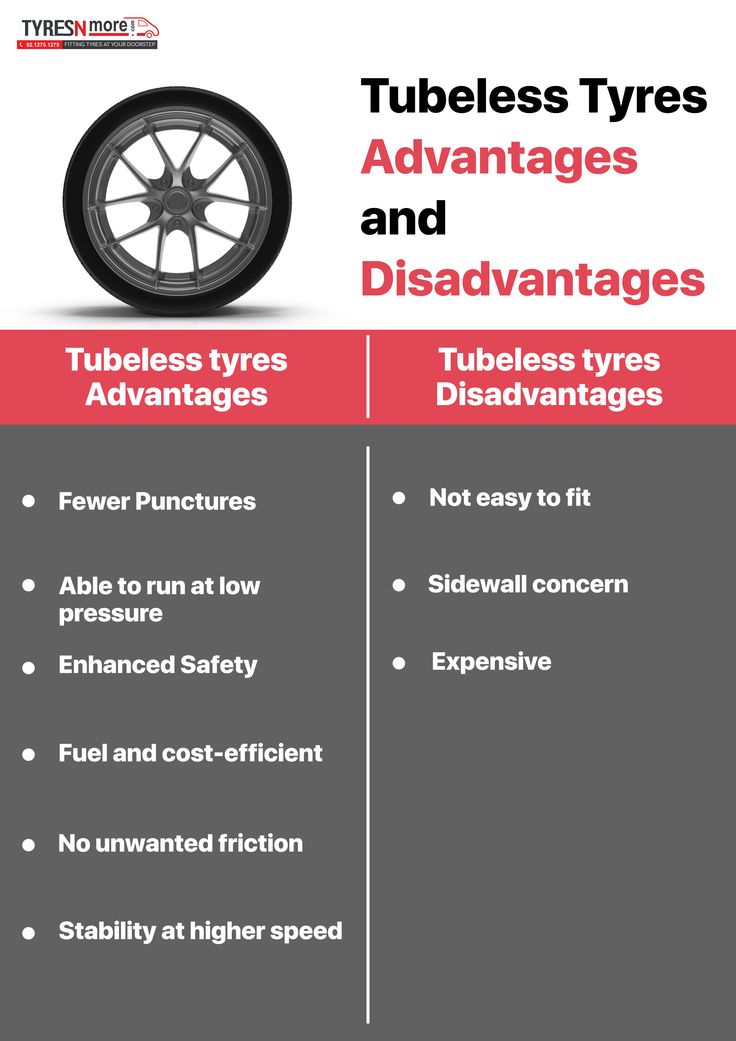 If you do not have such a can, then we advise you to buy it, sooner or later - it will save your nerves, time and mood. nine0003
If you do not have such a can, then we advise you to buy it, sooner or later - it will save your nerves, time and mood. nine0003
And so, if there is a nail or screw left in the tire, then it should not be removed immediately, first we connect the bottle with sealant to the nipple and if the bottle is new, then we completely inflate the wheel, if there is already insufficient pressure left in it, then before repair will need to pump up the wheel to at least 1 atmosphere.
After the sealant is pumped into the wheel, it is necessary to remove the foreign object, and the sealant under air pressure will seal the puncture site from the inside, but remember that this method of repair is temporary, and it will last for about 100 km, which is enough for a visit tire fitting. nine0003
It should also be remembered that the use of sealant disturbs the balance, and you cannot drive fast on such a wheel, the safest speed will be about 60 km / h.
This method is the most correct for emergency road repairs. Similar kits are sold in any automotive store, and even in any large supermarket. The kit usually includes a special awl to expand the puncture, a hook for the lace, the laces themselves with bituminous impregnation and, in some cases, glue. nine0003
Similar kits are sold in any automotive store, and even in any large supermarket. The kit usually includes a special awl to expand the puncture, a hook for the lace, the laces themselves with bituminous impregnation and, in some cases, glue. nine0003
Before carrying out repairs, in order not to spoil the integrity of the cord (the inner hard part of the wheel made of steel wire and nylon thread), it is worth reducing the pressure to 1 atmosphere. Then you should use an awl to clean and widen the hole, without which you will not be able to insert the lace. But you should not immediately remove the awl from the hole, otherwise the tire will release all the pressure and insert the lace will not work.
Then you should put the cord into the eye of the hook, distributing it equally on each side, after which the awl is taken out and the hook with the cord is put into the hole formed, here you should treat the action carefully and not overdo it. The lace should go into the tire about half or a little more (the sealing harness should be folded in half). nine0003
nine0003
After that, it is necessary to pull out the hook with one sharp movement, while the tourniquet will remain in the tire. Repair can be considered completed after cutting off excess pieces of lace and pumping the wheel to the required pressure.
It is worth noting that when using high-quality sets, this repair is considered to be complete and the puncture will be securely closed until the end of the wheel's service life. The only thing that may be required is balancing.
However, if the damage to the wheel is serious, then you will have to take care of buying a new tire. Recall that it is forbidden to repair cuts on the wheel, such a wheel is no longer allowed for operation even as a spare. Therefore, it is better to choose a cheaper tire than to pay for the repair of a cut, especially since today you can choose a new wheel even through your phone or from your home computer by visiting a specialized website.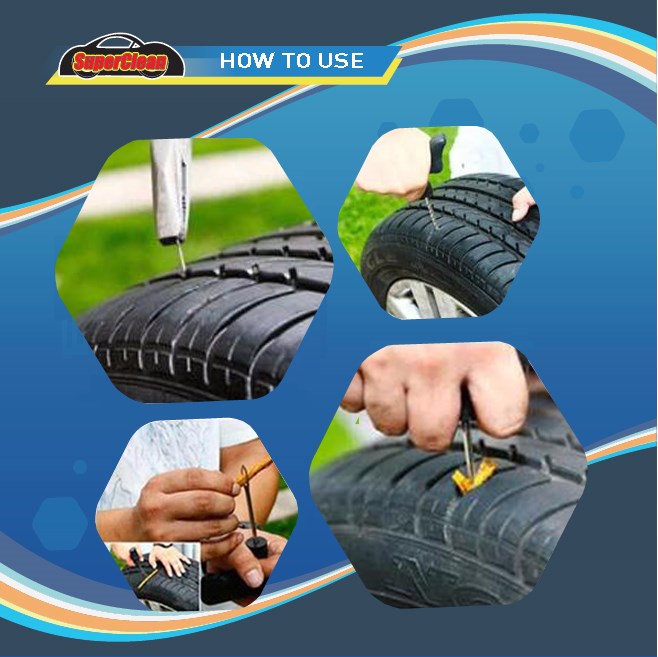 For example, one of these sites is the online store of tires and disks Internet-shina.ru at http://www.internet-shina.ru. nine
For example, one of these sites is the online store of tires and disks Internet-shina.ru at http://www.internet-shina.ru. nine
© 2007-2023.
The CarsWeek online publication was registered with the Federal Service for Supervision of Communications, Information Technology and Mass Communications (Roskomnadzor) on April 25, 2017.
Registration certificate EL No. FS77-69477. Founder: Sergey Grigoryevich Bogachkov. Chief editor: S. G. Bogachkov.
Editorial e-mail: [email protected]. Editorial phone: +7-915-979-14-25.
The use of site materials is allowed only with the installation of an active hyperlink to CarsWeek.ru. 16+
Modern passenger cars are equipped with tubeless tires. Tires with rubber chambers inside are extremely rare today, only on super-budget vehicle options. Car owners have long appreciated all the convenience and benefits that tubeless tires have. Unlike chambered rubber, they keep air in the wheels by being sealed to the rim. The tightness of tubeless tires is ensured by a two-millimeter layer of rubber applied to the tire from the inside. It is he who prevents the passage of air. The coating of soft rubber layer provides tightness at the junction of the tire with the rim of the rim. The tire bead sits on the so-called rim shelf, which is equipped with a special rounded ledge. Thanks to him, the tire is securely connected to the wheel rim, and complete tightness of the joint is achieved. A tubeless tire is filled with air through a valve installed on the rim, on its rim. nine0003
The tightness of tubeless tires is ensured by a two-millimeter layer of rubber applied to the tire from the inside. It is he who prevents the passage of air. The coating of soft rubber layer provides tightness at the junction of the tire with the rim of the rim. The tire bead sits on the so-called rim shelf, which is equipped with a special rounded ledge. Thanks to him, the tire is securely connected to the wheel rim, and complete tightness of the joint is achieved. A tubeless tire is filled with air through a valve installed on the rim, on its rim. nine0003
Why did tubeless tires become so popular that they gradually replaced tubed tires? First, tubeless tires are much lighter. This is a very important and great advantage, because heavy weight enhances the inertial movement of the wheel when driving on, to put it mildly, imperfect road surfaces, which we still have much more than smooth autobahns. As a result, this affects the condition of the chassis, accelerates its wear. In addition, tubeless tires do not heat up during driving in the same way that chamber rubber heated up, in which the inner cylinder rubbed against the tire while driving. Such friction led to its rapid wear, and also increased the likelihood of tire rupture during movement. When a tube is punctured, the tube tire loses air very quickly, since it escapes not only from the puncture site, but also through leaky tire beads that do not fit snugly against the rim flange. In addition, if such a tire is punctured, you will not be able to stop the car immediately, it will travel more than a dozen meters by inertia until it comes to a complete stop. During this time, the tube and the tire can be damaged more thoroughly, the rubber of the inner cylinder will “chew”. With tubeless tires, this option is excluded. Even if a puncture occurs, thanks to the tightness of the chamber and its periodic pumping, you can get to the tire service. nine0003
In addition, tubeless tires do not heat up during driving in the same way that chamber rubber heated up, in which the inner cylinder rubbed against the tire while driving. Such friction led to its rapid wear, and also increased the likelihood of tire rupture during movement. When a tube is punctured, the tube tire loses air very quickly, since it escapes not only from the puncture site, but also through leaky tire beads that do not fit snugly against the rim flange. In addition, if such a tire is punctured, you will not be able to stop the car immediately, it will travel more than a dozen meters by inertia until it comes to a complete stop. During this time, the tube and the tire can be damaged more thoroughly, the rubber of the inner cylinder will “chew”. With tubeless tires, this option is excluded. Even if a puncture occurs, thanks to the tightness of the chamber and its periodic pumping, you can get to the tire service. nine0003
Tubeless and tube tires also differ in how they are mounted / dismantled. If chambered rubber can be freely disassembled or, conversely, installed at home, then such a number will not work with a tubeless one - the risk of damaging the side flanges is too high, damage to which will lead to depressurization of the tire. Due to the peculiarities of installation and dismantling, many motorists find it impossible to repair a tubeless tire with their own hands, especially on the road, not in a comfortable garage, but on the side of the road. And in vain. Of course, it will not be possible to completely eliminate the problem at a professional level without special equipment. But to make sure that the damaged tire still travels, and sometimes not only reaches the tire fitting center, but goes more than one hundred kilometers after an impromptu repair, is quite realistic. nine0003
If chambered rubber can be freely disassembled or, conversely, installed at home, then such a number will not work with a tubeless one - the risk of damaging the side flanges is too high, damage to which will lead to depressurization of the tire. Due to the peculiarities of installation and dismantling, many motorists find it impossible to repair a tubeless tire with their own hands, especially on the road, not in a comfortable garage, but on the side of the road. And in vain. Of course, it will not be possible to completely eliminate the problem at a professional level without special equipment. But to make sure that the damaged tire still travels, and sometimes not only reaches the tire fitting center, but goes more than one hundred kilometers after an impromptu repair, is quite realistic. nine0003
To do this, use special tire repair kits, which can be purchased everywhere today by going to any car shop. Better yet, buy everything you need to repair a tubeless wheel yourself separately and always have it ready.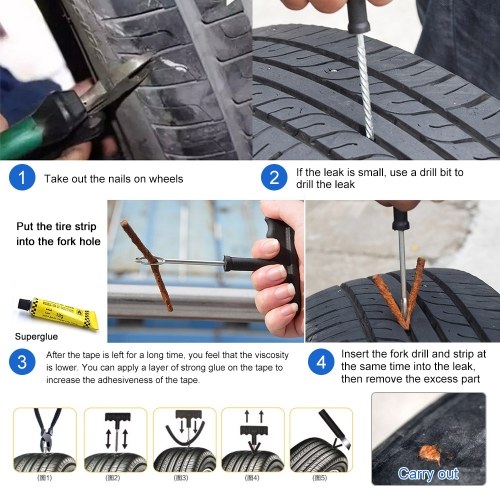 By doing this, you will save some money, which is always nice. The fact is that manufacturers of ready-made repair kits, in an effort to make their kits more expensive and solid in appearance, include in them both really useful tools and materials, as well as those that you can easily do without. Using repair kits or separately purchased harnesses and tools, you can repair tubeless tires not only for cars, but also for trucks. This can also be regarded as one of the advantages of tubeless tires over tube tires. It is much more difficult to repair it with a puncture. It is necessary to disassemble the wheel, remove the chamber, find the puncture site, and then degrease the working area, cut out the patch, and seal the rubber balloon. After drying, the camera is installed in place, and the wheel is beaded. With a tubeless tire, everything is much easier. nine0003
By doing this, you will save some money, which is always nice. The fact is that manufacturers of ready-made repair kits, in an effort to make their kits more expensive and solid in appearance, include in them both really useful tools and materials, as well as those that you can easily do without. Using repair kits or separately purchased harnesses and tools, you can repair tubeless tires not only for cars, but also for trucks. This can also be regarded as one of the advantages of tubeless tires over tube tires. It is much more difficult to repair it with a puncture. It is necessary to disassemble the wheel, remove the chamber, find the puncture site, and then degrease the working area, cut out the patch, and seal the rubber balloon. After drying, the camera is installed in place, and the wheel is beaded. With a tubeless tire, everything is much easier. nine0003
RUNWAY Tubeless Tire Repair Kit, 7-Piece
If you find that your car's tubeless tire wheel is damaged, first assess the severity of the situation. If, in your opinion, you can do without repair, having reached a reliable tire service on periodic pumping of the wheel, then it’s better to do so. Tubeless tires were designed to hold air even with foreign objects sticking out of the cord. But do not forget that riding with a nail or other object in the tire causes the puncture to gradually expand and the tire around the damaged area begins to gradually collapse. nine0003
If, in your opinion, you can do without repair, having reached a reliable tire service on periodic pumping of the wheel, then it’s better to do so. Tubeless tires were designed to hold air even with foreign objects sticking out of the cord. But do not forget that riding with a nail or other object in the tire causes the puncture to gradually expand and the tire around the damaged area begins to gradually collapse. nine0003
But, if it so happens that the damage to the wheel received on the road is too extensive, the chamber does not hold air and it will not be possible to complete the journey while inflating the tire, you need to choose the best method of temporary repair and start it immediately. A tubeless tire is repaired in the following ways:
When choosing a repair using a tourniquet, you need to decide what type of material will be used. The harness can be cord or rubber. Let's consider both of these options. nine0003
Wheel repair kit, 6 pieces
Cord harness has found wide distribution as a repair material for tubeless tires. With this harness, you can carry out repairs in any conditions: on a city street or on the side of a country road. It is a strip of high-strength nylon, which is richly impregnated with high-quality rubber-based adhesive. Such harnesses are supplied to the domestic market by many manufacturers, they have certain differences in technical characteristics and cost. But all cord harnesses are installed according to the same type of scheme: nine0003
With this harness, you can carry out repairs in any conditions: on a city street or on the side of a country road. It is a strip of high-strength nylon, which is richly impregnated with high-quality rubber-based adhesive. Such harnesses are supplied to the domestic market by many manufacturers, they have certain differences in technical characteristics and cost. But all cord harnesses are installed according to the same type of scheme: nine0003
First of all, they find the place of damage and mark it with wax crayon or another marker.
Remove the item that damaged the tire if it is stuck in the cord.
Then you should check the tire pressure, it should not fall below 0.5 atmospheres.
Take a spiral awl and use it to determine at what angle the tire is damaged. nine0003
Apply vulcanizing glue to the awl.
Using the awl inserted into the puncture, coat the puncture site with glue in the most thorough way, for which you need to rotate the tool lubricated with it clockwise.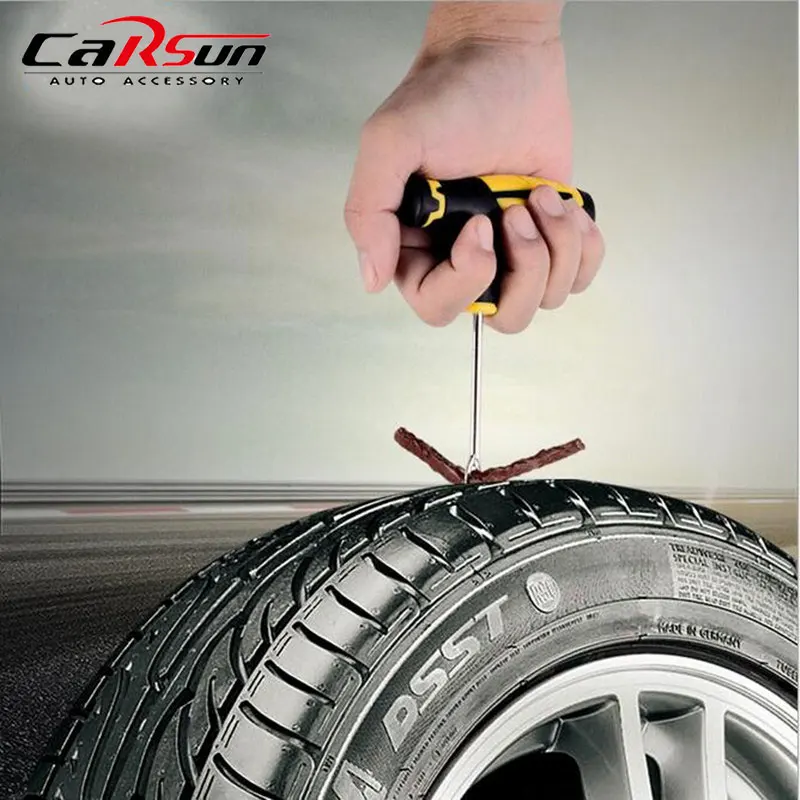 Perform this action three times - lubricate the awl and insert it into the puncture, then leave the tool in the cord for the time being.
Perform this action three times - lubricate the awl and insert it into the puncture, then leave the tool in the cord for the time being.
Insert the tourniquet into a special needle, focusing on the center.
On both sides, cover the surface of the tourniquet with vulcanizing glue.
Remove the helical awl from the tire where you left it at the puncture site.
nine0114Install a pen with a needle and a tourniquet placed inside into the puncture.
By pressing the handle, install the needle with the tourniquet into the puncture, advancing to the stop at a given angle.
Remove the pen with the needle from the puncture site without rotating it.
Carefully cut off the parts of the tourniquet sticking out on the surface. nine0003
Then you need to determine how tight the tire is repaired. This can be done with the help of a special liquid, which is used to determine the puncture site. If, after applying such a liquid, no air bubbles appear, then the tire is temporarily repaired and can be used further. If air bubbles appear, try installing an additional tourniquet in the place of damage to the tire.
This method of temporary repair is inexpensive, but it has proven its effectiveness more than once. A tire repaired in this way without repair will serve you for a long time - up to 6 months. nine0003
A rubber harness costs more than cord, but it is also more reliable. They install it in much the same way as the cord one, but there are still some differences. For example, when installing a rubber band, do not use an awl in the form of a rasp, since it can damage the rubber band during installation. In addition, the rubber band must be mounted on the adhesive specified by the manufacturer in the instructions for the repair kit.
Raw rubber band for repairing RUNWAY tubeless tires, 5 pcs
In this case, an anchor is a special type of bundle, one end of which ends with a small patch. The anchor is installed in the same way as other types of harnesses, but in addition, it glues the puncture site with an internal patch. To do this, the tourniquet is pushed inward, and then pulled a little in the opposite direction. Anchor can only be installed using a special cutter with a diameter of 6 mm. It is purchased separately from the set. But your efforts will surely be crowned with success, because the anchor is considered the most reliable option for repairing a tubeless tire with a harness. But with the help of harnesses, you can not repair side punctures. And in any case, even if the repair is successful, it is necessary in the coming days to choose the time to visit the tire service. Remember that prolonged use of the harness will cause irreversible damage to the tubeless tire. And until the problem is fixed, constantly monitor tire pressure. nine0003
And until the problem is fixed, constantly monitor tire pressure. nine0003
The second option for repairing tubeless tires involves the use of sealant. This option cannot be called optimal, but it has become widespread, since tire repair in this way is carried out very quickly, literally in a matter of minutes. And the result of its implementation is guaranteed to allow you to get to the intended purpose of the trip, without first stopping by the tire service you met along the way.
The sealant is very easy to apply. In this case, it is not necessary to remove a nail or other object from the cord, due to which the tire was damaged. Simply attach a bottle filled with sealant to the valve on the rim of the wheel and see that the contents of the bottle are pumped into the wheel. Keep in mind that repairing a tire with sealant will significantly disrupt the balance, so choose a moderate speed. But on the other hand, repairs with the help of a sealant are easy, simple and very fast.